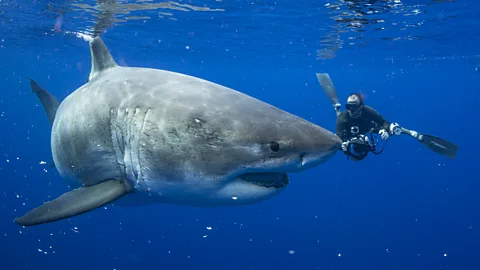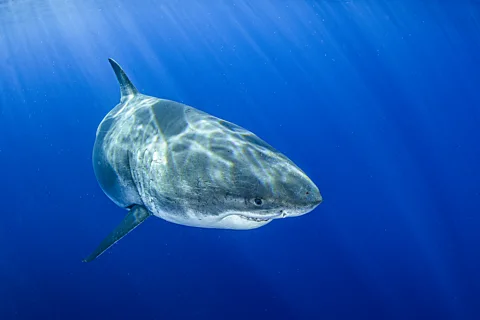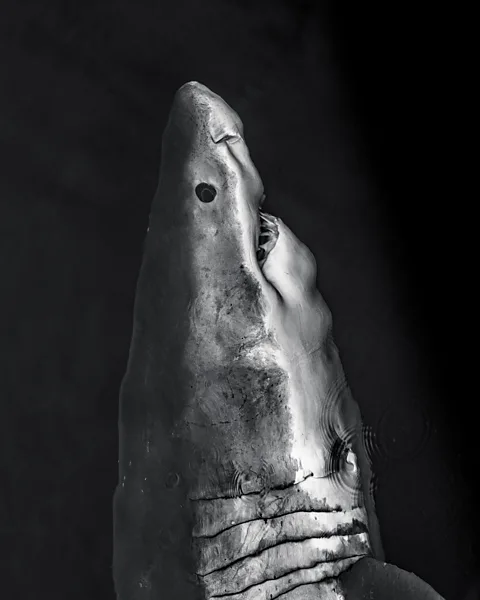The antidote to the Jaws effect: These photos show a softer side of great white sharks
 Kimberly Jeffries
Kimberly JeffriesFifty years since the release of Jaws, these photographers are showing a different, less frightening view of great white sharks.
Mike Coots, a keen surfer in the waters of his native Hawaii, was 18 when he was bitten by a tiger shark.
"It came from right underneath me and latched on", the photographer, now 44, recalls. "I felt this huge pressure but no pain. It was like an out of body experience."
The shark shook him back and forth "like a rag-doll", Coots says, until he managed to punch it three times on the nose, cutting his hand against its teeth as he did so. "It wasn't until I was paddling back into shore that I realised my leg had been completely severed and that there were big spurts of blood [coming from the stump] with each heartbeat."
Remarkably, Coots was back in the water with a new prosthetic leg just a month later. More remarkably perhaps, he has now become an advocate for shark conservation, using his pictures to help show a more naturalistic image of sharks than is often found in media and films.
"I'd taken this one shot off New Zealand in 2009 [of a shark exhibiting a behaviour called spy hopping, where it pokes its head up out of the water] and it became something of a meme," says Coots. "I started to see it all over, and the comments weren't, 'That's the scariest thing I've ever seen', but about how amusing it was, how it expressed curiosity, even personality. It was an 'a-ha!' moment for me – that the right images could shift us away from the usual demonisation of sharks."
 Mike Coots
Mike CootsCoots is among a wave of campaigning underwater photographers, including Kimberly Jeffries, George Probst, Caterina Gennaro and Renee Capozzola, who are attempting to overhaul our poor and often fearful view of sharks to help advocate for their conservation. Their images are typically up close and aim to capture natural shark behaviours – schooling, mouthing, bumping – rather than the aggression often expressed in photos, which is sometimes induced by using bait pulled behind a boat.
It's an ongoing battle, with the legacy of films like Stephen Spielberg's pioneering blockbuster Jaws, which marks its 50th anniversary this week, continuing to be seen in portrayals of sharks today.
"Sharks still need better PR. They're not monsters," says Jeffries, a conservationist and underwater photographer who shoots for National Geographic and is currently working with Disney on a live-action remake of Finding Nemo.
Her images aim for the true-to-life over the artificially dramatic: great whites seemingly smiling to camera, mindfully cruising with dolphins, just peaceably hanging out with divers.
"I find that when people without direct exposure to sharks, which is most people, are exposed to what I consider to be the right imagery, they really like it," she says. "They're fascinated and find this more honest representation of sharks can help them reconnect with ideas of co-existing with nature."
One of her shots, featured below, is a 2019 image of a shark nicknamed Deep Blue, believed to be one of the largest great whites ever encountered. Jeffries was "absolutely honoured" to have dived with such a large shark, she says. "She was incredibly elegant and had a stately presence."
 Kimberly Jeffries
Kimberly JeffriesCoots, meanwhile, now explores taking pictures of sharks using specially-adapted portraiture lenses, better able to their catch physical details, true scale and the light in a shark's eyes including the iris – unlike the typical depiction of them being blacked-out and doll-like. "And if I get a media request for the usual sensationalist shark picture – mouth open, teeth bared – I decline," he says.
James Ketchum, director of Pelagios Kakunja Marine Conservation, which focuses on the study of sharks and mantas in Mexico, says Coots' photos are unusual in "capturing the real animal, its real behaviour and beauty rather than the much more commonplace 'shark porn' we've long seen".
Of course, he adds, a shark is a natural predator. "But it's films like Jaws, and the commercial shark photography that's followed it, that has focused both on just one idea of what a shark is, and on just a few of the many shark species too. It's images like Coot's that are helping us break away from [that]."
Images are as important in giving an accurate representation of the animals as the data that scientists work with, Ketchum argues, and tend to reach the general public much faster. "Images are more approachable."
Still, it's an uphill climb, he says. Sharks continue to contend with their villainous image as our go-to, real-life bogeyman. It's an image that affects few other animals so strongly, he says, except perhaps piranha or wolves.
The huge success of Jaws played a big role in developing this view of sharks. A key scene in the film sees a character recount the true story of massed shark attacks on the crew that survived the sinking of the USS Indianapolis during World War Two, 80 years ago this July.
Indeed, the impact of Jaws on the vilification of sharks is, Coots believes, hard to understate. David Shiffman, marine conservation scientist and author of Why Sharks Matter, agrees. "I don't think people really thought about sharks much at all much before Jaws, but its effect has been very real," he says. "It proved a genuine turning point [in the way we perceived sharks]."
Jaws spawned a genre that has maintained that frightening image, from Deep Blue Sea and Dark Tide to The Shallows, and The Meg and Meg 2 (about a killer megalodon, a species of giant shark extinct for more than three million years – learn more about this prehistoric creature in this article). Most recently, in 2024 Under Paris, about a killer shark in the Seine, became a box office success (and look out for Dangerous Animals, just out, followed by Fear Below and Deep Water later this year).
 Kimberly Jeffries
Kimberly JeffriesThe great white shark is nearly always the focus of these films. Among the 500-plus shark species, great whites are only the sixth largest, but, some data suggest, are responsible for the most unprovoked attacks on people.
"Now we have the likes of the Sharknado movies, which I love, because they don't take themselves too seriously," says Shiffman. "Unfortunately, there are many other shark films that do. And [their reach is such that] it's going to take a lot to counter the effects of those."
An IPSOS poll in 2015, more than four decades after the Jaws release, found that 51% Americans are terrified of sharks, with 38% scared to swim in the ocean because of them. Being terrified of sharks ran highest in the Northeast followed by those, perplexingly, in the Midwest, a long way from the sea. One 2016 study found that setting a 60-second video clip of sharks swimming to ominous background music (as opposed to uplifting music or silence) was enough for participants to rate sharks more negatively.
In March, the Ocean Lovers Festival in Sydney, Australia launched its inaugural Jawsie Awards, a "sharky parody, criticism and satire on sensational representations of sharks, such as those included in the movie Jaws". Winner of 2025's most sensationalist reporting award went to Shark Week, an annual week of shark documentaries by the Discovery Channel, for its episode Megalodon: The Monster Shark Lives.
This all despite the fact that shark-human interactions in the real world are actually vanishingly rare. The Florida Museum of Natural History's International Shark Attack File reported just 47 unprovoked shark attacks on people globally in 2024 (and 24 "provoked" ones, where human had initiated interaction with a shark in some way). Seven of these incidents were fatal, down from 14 in 2023. Elephants and even bees kill more people each year. (Read more about the real reason why sharks attack humans.)
But it's not just in the movies that sharks get scary PR. The hugely popular 2020 video game Maneater, for example, has now sold over 14 million units. And a 2012 study of the Australian media suggested shark attacks were reported five times more frequently than conservation or other shark-related topics.
 Mike Coots
Mike CootsThis kind of hype isn't new. A series of fatal great white shark incidents along the New Jersey shore in 1916, said to have inspired Peter Benchley to write the 1974 novel Jaws, sparked a shark panic and calls for the eradication of the local shark population.
"This [biased perception] is easy to understand," says Lisa Whitenack, professor of biology and geology at Allegheny College in Pennsylvania and lead author of a study on the representation of sharks in TV media. "The ocean is a scary place, you can't see what's in it and sharks do look scary. They're predators, move fast, have those eyes, so watching them on TV from the safety of our living rooms is akin to the thrill of horror films."
While Whitenack says Jaws is "an excellent horror film", she wishes it "hadn't done the damage it did". "On the one hand it's allowed some people to make a good living out of demonising sharks, and on the other it's led to a [relative] lack of interest in shark conservation," she says. Entertainment is potent, she stresses. "Now I get people asking me if the megalodon is really out there."
Spielberg himself has spoken of his own regret of how the Jaws book and film fuelled the decimation of sharks. Speaking to BBC Radio Four's Desert Island Discs in 2022, he said he still fears "that sharks are somehow mad at me for the feeding frenzy of crazy sword fisherman that happened after 1975, which I truly and to this day regret".
Even media purporting to celebrate sharks, however, has been accused of falling for sharkphobia. Whitenack led a 2022 study on 32 years-worth of Shark Week, which was launched by in 1988. It concluded that what Whitenack calls "fear-mongering, bias and inaccurate representations of science" was prevalent in the series, and found that 74% of the episodes included in the study contained "some sort of fear-mongering language or negative portrayal of sharks". Some 15% of episodes were about shark attacks. The Discovery Channel did not respond to a request for comment about this criticism ahead of publication.
Results like these are concerning, says Shiffman, at a time when shark conservation is increasingly critical. While fear-mongering about sharks isn't the main driver of declining shark populations – that is due to them being netted as by-catch alongside demand in Asia for shark fin soup and the shark meat trade – it leads the public to not care enough to do anything about these problems, he says.
 Mike Coots
Mike CootsFishing accounts for the death of some 80 million sharks every year, 25 million of them threatened species. Save Our Seas, a Geneva-based non-profit, estimates that 18% of shark species are now endangered or critically endangered. Meanwhile, we're only just coming to appreciate the crucial role that sharks, as apex predators regulating the populations of other species, play in maintaining the health of the marine eco-system.
"The problem is that the negative perception of sharks in various media still shapes politician's readiness to protect them, even though that lack of protection [has a knock-on] impact on other marine life that we do say we care about," says Alexander Godknecht, chair of conservation organisation the Shark Foundation. "A simple example: sea stars eat coral. It's the sharks that eat the sea stars."
More naturalistic shark photography, says Godknecht, is "really helping" to make a more positive story about sharks, as is more realistic content of documentaries.
More like this:
• The real reasons why sharks attack humans
• The polar bears living in an abandoned Arctic weather station
The shift seen in shark representation so far through photography is a start, says Christopher Pepin-Neff, co-founder of the Jawsie Awards, author of Flaws: Shark Bites and Emotional Policy Making and a professor in public policy at the University of Sydney. But further sources giving balanced depictions of sharks are still needed, says Pepin-Neff, who has studied public behaviour around shark attacks. "This is not just a matter of better education but, at the moment, of tackling miseducation – the idea that all beaches are safe but that all sharks are dangerous is obviously false."
This is the "old fish story" that, one of Pepin-Neff's studies concludes, politicians like to push to their own ends, even contrary to the public's more sophisticated attitude towards sharks. "That sharks are bad, that it's the shark's fault – these are easy and wrong narratives to push," Pepin-Neff says.
Jeffries finds there is "less and less demand for the gory, thrashing, shock and awe kind of shark imagery now and more demand for truthful, ethical storytelling".
"That's important," she says, "because the fact is that we're less willing to save what we fear."
--
For essential climate news and hopeful developments to your inbox, sign up to the Future Earth newsletter, while The Essential List delivers a handpicked selection of features and insights twice a week.
